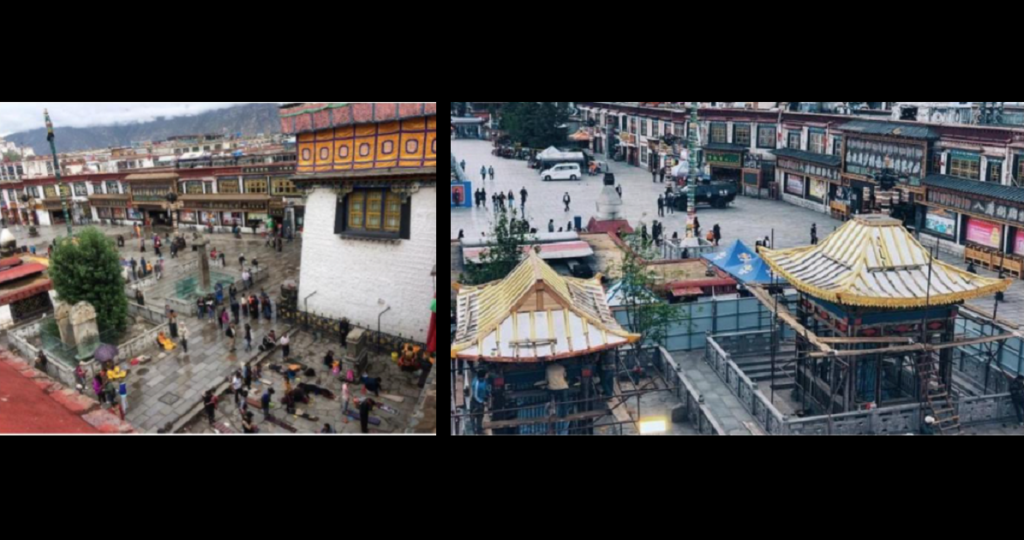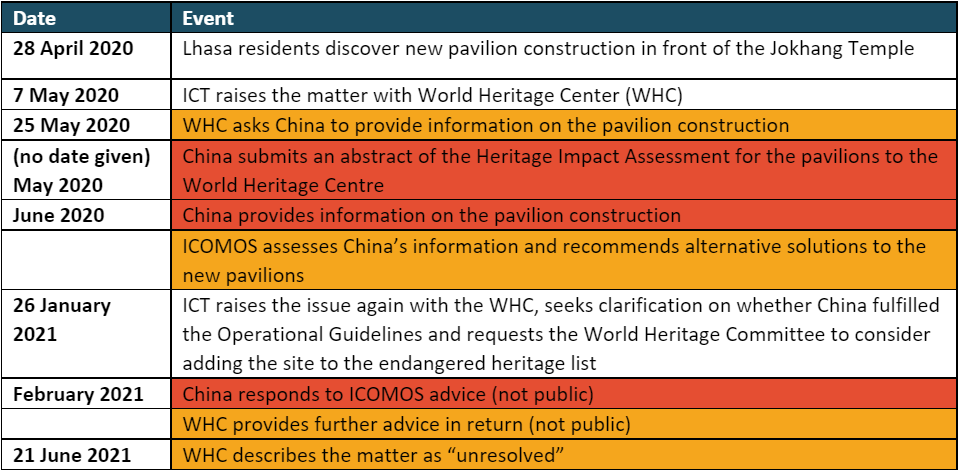The COP15 on biodiversity is a meeting of countries signatory to the convention on global biodiversity. Although the meeting on biodiversity enjoys less fanfare than its climate change meeting counterpart, this 15th meeting of the parties is a major calendar event. It is carving out a post-2030 global framework for biological diversity conservation, and it is being ambitious in setting targets and indicators. Biodiversity is critical, as it is a measure of the earth’s environmental health and resilience—something we will need as we face increasing pressures from climate change.
While there are many contestations in the negotiations, the International Campaign for Tibet is concerned by the methods used to achieve the targets. Any solution to biodiversity should always include human rights protections, such as the right to information, right to consultation, and right to participation, remedy and compensation in cases of abuse.
In the past, it has not been enough to push for such human rights protections. For many, human rights seem unrelated to the issue of biodiversity, dismissed as an unrelated political issue, agenda or distraction. But in this article, I want to show how human rights protections offer an alternative future for biodiversity conservation in Tibet, one that is worth pursuing. I want to do this through a counterfactual for the situation in Tibet. I want to explain how human rights protections and genuine participation can empower and activate a community whose health is tied to its regional biodiversity. Through a counterfactual, I hope to show why it is just as important to set the standards on methodology and not just the end goals of biodiversity. These lessons will not only be relevant to biodiversity, but also climate change responses.
Tibetans: ecological natives and environmental stewards?
First of all, I’m not offering up Tibetans as model “native ecologists” or natural “environmental warriors.” Tibetans, Tibetan culture and Tibetan Buddhism cannot and should not be essentialized and simplified to fit an externally defined environmental criterion to be deemed worthy of attention and support. More importantly, western concepts of ecology, environmental protection and climate change don’t fit neatly with the Tibetan worldview or the vocabulary that Tibetans use when they engage with environmental issues. However, Tibetans are environmentally conscious and conveniently endowed with cosmological and normative frameworks that should not be lost and that make them well suited to designing sustainable environmental initiatives in their homeland. Here I want to draw out some of the concepts in the Tibetan worldview and religion to demonstrate why empowering Tibetans to speak up and engage without fear is so important for Tibet’s environment.
Tibetan cosmology: mutually sustaining relationship with nature and deities of the landscape
Cosmology is how we understand our creation and relationship with nature and the universe. Tibetans have a cosmology grounded in the concept of “the container and its contents.” The container is the world, and the sentient beings are the contents or the inhabitants. While Tibetans can and do interpret this analogy in slightly different ways, the essence is that the container and its contents exist in an interdependent relationship.
In addition to this, worldly territorial spirits and deities inhabit the natural landscape, such as lakes, mountains and rivers. These spirits have agency and can be both benevolent (providing protection and prosperity) and wrathful (unleashing natural disasters and other misfortunes) based on the conduct of local individuals or the community.[1] With this worldview, Tibetans live in a mutually sustaining relationship with the nature and the deities of their local land. This cosmology predates the arrival of Buddhism to Tibet and is rooted in indigenous traditions.
This view treats all land as important, with sacred sites perceived to be more critical. To illustrate this, some Tibetans draw an analogy with the body and its organs, arguing that injuring a sacred mountain is similar to injuring a critical organ like the heart or brain.[2] Combining this with the interdependent relationship between the container and its contents, one elderly Tibetan pastoralist describes how “digging gold from the mountain is like taking my heart out of my body.”[3]
Tibetan Buddhism
Buddhism arrived in Tibet in the seventh century under the reign of King Songtsen Gampo and has since become the dominant religion of Tibetan society. Buddhist principles of no-self, interdependence, compassion, non-harming and karma have significantly shaped Tibetan views and approaches to the natural environment, especially in the treatment of living beings.
While these concepts do shape a broader Buddhist environmental philosophy or ethics, there is no singular definition of Buddhist environmental philosophy. As a result, there can be variations in how Buddhist principles are interpreted in the environmental context. For example, as Emily Yeh points out, the Buddhist law on cause and effect and, in particular, the concept of karma can treat environmental destruction as the fruit of past individual and communal karma, which can only be corrected with improving one’s mind and conduct over infinite lifetimes.[4] Extending this logic, an individual could choose to seek spiritual education and service to others with a goal to benefit future lifetimes over engaging in immediate environmental interventions in the present.
Putting it all together: conserving biodiversity
Conserving biodiversity requires a people who are empowered and a culture rooted in environmental consciousness. So, if human rights protections are secured in the post-Global Biodiversity Framework, how might Tibetans apply their cosmology and Buddhist religion to manage biodiversity? One successful example is the management of sacred sites.
Sacred landscapes
Local Tibetan communities or monasteries have already taken the initiative to manage sacred sites, with some even negotiating legal rights through community conservation agreements.[5] Through establishing environmental associations or NGOs, or working through existing monastic institutions, Tibetans have been protecting sacred sites by engaging in activities such as monitoring and regulating hunting, fishing, logging, mining, grazing, harvesting or other destructive activities. Some have also been cataloguing and monitoring local flora and fauna, replanting trees, and organizing waste removal as well as community environmental education activities. Many have also begun with sacred sites and extended their work into other landscapes. What is distinct about their approach is that Tibetans are not prioritizing specific animals above others or drawing on financial rewards to induce good behavior.
Tibetan environmentalists have found that drawing on Tibetan cosmology, culture and Buddhism is useful for environmental protection, as these traditional frameworks shape the rules of human use of nature and make environmental protection an ethical, rather than economic, issue. In doing so, it creates a culture of self-surveillance and accountability.
Human rights: a prerequisite
For Tibetans inside Tibet working on environmental issues, it has been clear that “Tibetan cultural survival, religious continuity and ecological health are inseparably linked.”[6] However, it is equally important to recognize that human rights are the prerequisite for all.
We saw this with Rinchen Samdup, who drew on Tibetan culture and religion to mobilize his community around illegal poaching and deforestation in his area. In 2003, Rinchen together with his brother Karma Samdup and friend Tador created an environmental group with more than 1,000 adult residents from 11 hamlets. They drew up a detailed list of rules and fines for hunting and fishing in their community area and plans for afforestation that saw half a million sea buckthorn, spruce and poplars in the first two years. They also organized community garbage clean-ups, wildlife patrols and monitoring, and environmental education activities, including the publication of an environmental protection journal.
Rinchen later went on to co-found the Three Rivers Environmental Protection Group with his brothers Karma Samdup and Chime Namgyal. Despite being recognized as award-winning environmental activists, Rinchen and Chime were arrested in August 2009 for challenging a local police chief who hunted endangered species on a Tibetan nature reserve.[7] Rinchen was sentenced to five years in prison, while Chime received a 21-month prison sentence. Karma, who lobbied for their release, was arrested on Jan. 3, 2010 and subsequently sentenced to 15 years in prison. He is due for release in 2025.
As long as human rights are not protected, meaningful environmental protection work and biodiversity conservation will remain precarious and secondary.
Footnotes:
[1] Annabella Pitkin, ‘Sustaining the Sacred Mountains: Tibetan Environmentalism and Sacred Landscape in a Time of Conflict’. Volume II Intellectual History of Key Concepts, edited by Gregory Adam Scott and Stefania Travagnin, Berlin, Boston: De Gruyter, 2020, page147.
[2] Emily Yeh, ‘Reverse environmentalism: Contemporary articulations of Tibetan culture, Buddhism and environmental protection’. Religion and Ecological sustainability in China, edited by James Miller, Dan Smyer Yu, and Peter van der Veer, 2014, page 192.
[3] Yonten Nyima and Emily Yeh, ‘Environmental Issues and Conflict in Tibet’. Ethnic Conflict and Protest in Tibet and Xinjiang: Unrest in China’s West, edited by Ben Hillman and Gray Tuttle, Columbia University Press, 2016, page 168.
[4] Op. Cit., Yeh, ‘Reverse environmentalism: Contemporary articulations of Tibetan culture, Buddhism and environmental protection,’ 2014, pages 201-204.-
[5] See cases such as the Voluntary Association for the Protection of the Natural Environment of Domed Anchung Sengge Namzong, Khawakarbo Culture Society, Nyanbo Yutse Environmental Association, and more small scale local village initiatives such as anti-poaching patrols on Karpo Lhasham mountain in Gomri village, Hashul Township, Yushul prefecture, Qinghai.
[6] Op. Cit., Yeh, Reverse environmentalism: Contemporary articulations of Tibetan culture, Buddhism and environmental protection,’ 2014, pages 214-215 and Pitkin, ‘Sustaining the Sacred Mountains: Tibetan Environmentalism and Sacred Landscape in a Time of Conflict’, 2020, page 193.
[7] International Campaign for Tibet, 4 August 2010, ‘”A sharp knife above his head”: the trials and sentencing of three environmentalist brothers in Tibet’, https://savetibet.org/a-sharp-knife-above-his-head-the-trials-and-sentencing-of-three-environmentalist-brothers-in-tibet/.



